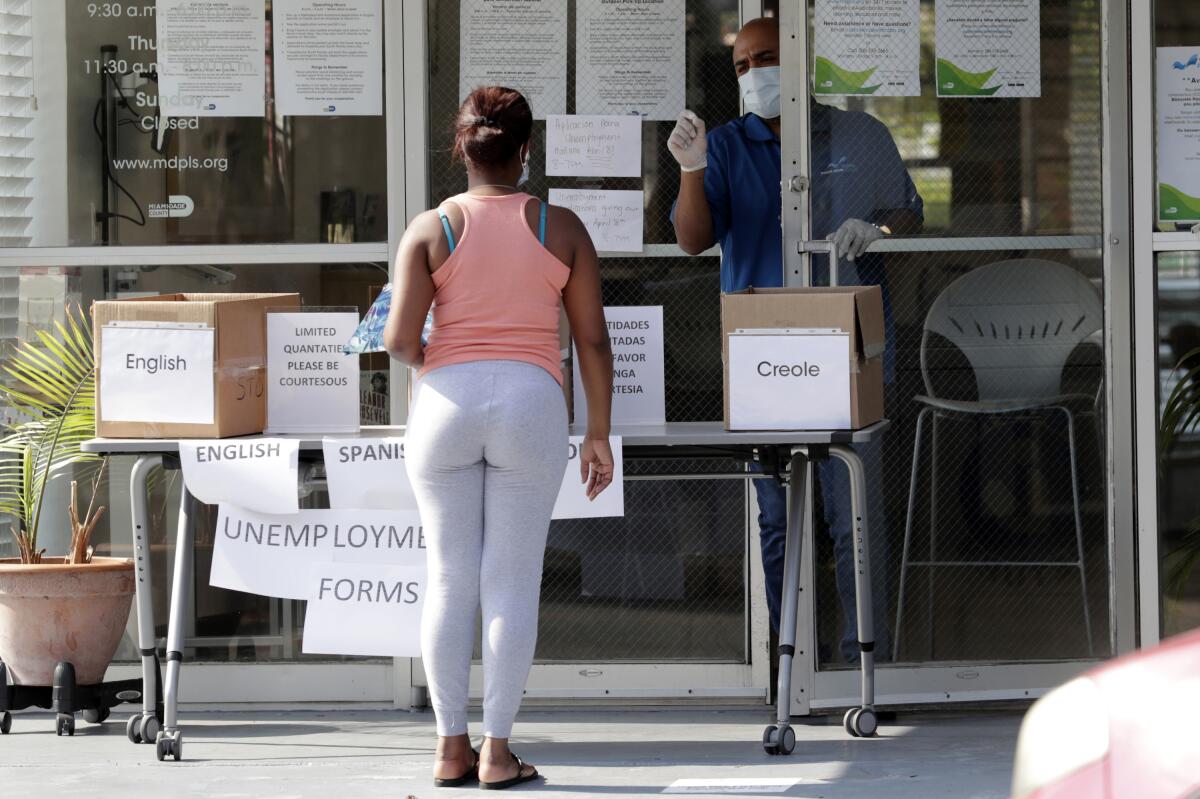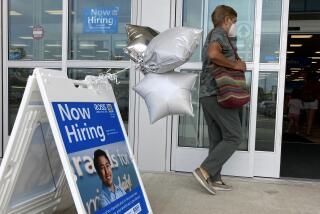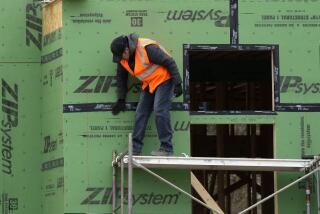The unemployment rate may be even worse than it looks

- Share via
The April unemployment report is at least as bad as economists predicted: Based on a survey of U.S. households, the unemployment rate leaped from 4.4% to 14.7% as nearly 16 million people joined the ranks of the jobless. It was the highest rate recorded since the surveys began in 1948, and the biggest one-month increase.
But the truth is, the real statistics may be much, much worse. And even if they aren’t, they convey a discouraging message about the months ahead.
The monthly jobs report from the Bureau of Labor Statistics includes two sets of numbers, one based on reports from employers (the establishment survey), the other on interviews with workers (the household survey). The establishment data were a little less grim, showing that the total number of jobs shrank by 20.5 million, versus 22.4 million in the household survey. Either way, the results were record-setting, and not in a good way.
Two more firsts: The ratio of workers to total population fell 8.7 percentage points, the largest drop ever recorded, to 51.3%, the lowest level on record. The all-important labor-force participation rate, which measures the number of people working or actively looking for work, fell to 60.2%, the lowest rate in 47 years.
Former Obama administration chief economist Jason Furman teased out the larger meaning of the lower labor force participation rate:
Then there’s this observation that Bureau of Labor Statistics Commissioner William W. Beach included in his comments: “In addition to the increase in the number of unemployed people, there was also an increase in the number of workers who were classified as employed but absent from work for the entire reference week.” Beach raised the possibility that these workers may actually be temporarily unemployed — furloughed on account of pandemic-related restrictions. If these workers did indeed fall into that category, Beach wrote, “the overall unemployment rate would have been almost 5 percentage points higher than reported (on a not seasonally adjusted basis).”
In other words, nearly 1 in 5 working Americans may be in line for unemployment benefits. The one hopeful caveat here is that fewer people responded to the household survey than usual — 70%, down from about 83% — so it may not be as accurate as usual.
The BLS establishment survey showed that the pandemic has cut a broad swath through U.S. industries, with every sector reporting job losses (with the exception of some subcategories, such as big-box retailers). Some of those losses appeared to be ephemeral, such as the half a million jobs lost in dentists’ offices, which should bounce back as soon as the pandemic restrictions lift.
Others will revive only as quickly as people regain confidence in their ability to go out and about without risk of contracting or spreading a potentially fatal illness. That category includes the leisure and hospitality industries, where the job losses (7.7 million) neared 50% and arts, entertainment and recreation industries (1.3 million jobs lost).
The rest of the job losses reflect the pandemic restrictions’ domino effect, and the larger recession that we’re sinking into. They’ll rebound more slowly, as more Americans get back on their feet, consumer spending picks up and businesses grow more optimistic about the future. These include the 2.1 million jobs lost by retailers, the 1.3 million jobs lost in manufacturing, the nearly 1 million lost in construction, the 584,000 lost in transportation and warehousing, and the 363,000 jobs lost in wholesale trade.
President Trump put a happier spin on the jobs report; according to Aaron Blake of the Washington Post, Trump said Friday morning that “those jobs will all be back, and they’ll be back very soon.” But Furman crunched the numbers and saw something different:
Numerous economists have been saying since the early days of the pandemic that the single most important thing the country can do to help the economy is to beat the coronavirus — not just for public health reasons, but for psychological ones. That’s still good advice today, as more businesses in California and across the country start to reopen in the hope that customers can and will return.
More to Read
A cure for the common opinion
Get thought-provoking perspectives with our weekly newsletter.
You may occasionally receive promotional content from the Los Angeles Times.










